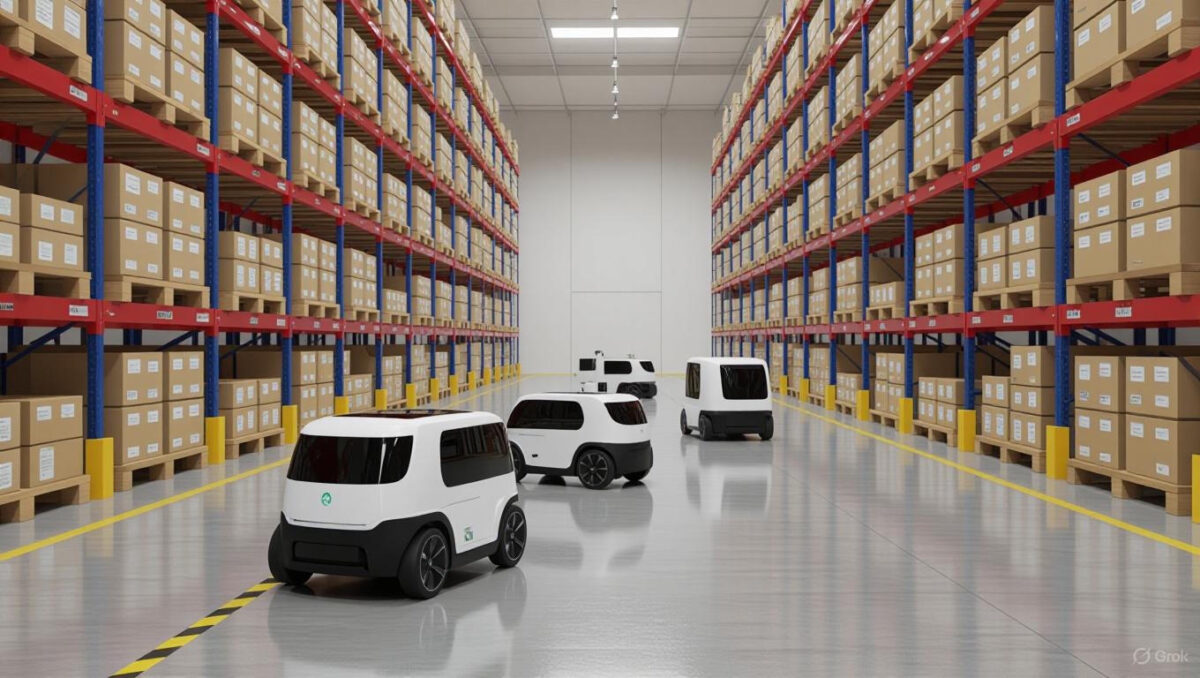How Autonomous Warehouse Robots Are Shaping the Future of Warehousing

Introduction
The logistics and warehousing industry is undergoing a major transformation, and one of the driving forces behind this shift is the rise of autonomous warehouse robots. These advanced robots are not only enhancing operational efficiency but also shaping the future of how warehouses and distribution centers function. As autonomous mobile robots for warehouse become more advanced, they are helping businesses streamline processes, reduce costs, and improve safety.
In this blog, we will explore how autonomous warehouse robot are changing the landscape of warehouse automation, the role they play in enhancing robotics warehouse operations, and why they are essential for the future of warehousing.
What Are Autonomous Warehouse Robots?
1. Defining Autonomous Warehouse Robots
Autonomous warehouse robot are robots that operate independently in warehouse environments without the need for human intervention. These robots are equipped with sensors, artificial intelligence (AI), and machine learning algorithms that allow them to navigate the warehouse, perform tasks, and communicate with other systems within the warehouse. Their autonomy allows them to work around the clock, increasing the efficiency and speed of warehouse operations.
Unlike traditional robots that require human input or remote control, autonomous robots are capable of decision-making based on their environment and predefined tasks. This level of automation in warehousing is transforming how goods are handled, moved, and sorted within distribution centers.
Benefits:
- Self-operating robots with no human control.
- Higher efficiency in warehouse operations.
- 24/7 productivity, reducing downtime.
The Role of Robotics in Warehouse Automation
2. How Robotics Warehouse Systems Are Enhancing Efficiency
The integration of robotics warehouse systems into warehousing operations has significantly improved operational efficiency. Autonomous warehouse robot can perform a variety of tasks, including inventory management, order picking, sorting, and material handling, all while operating with high precision.
These robots work collaboratively with automated systems, such as conveyor belts and sorting systems, to seamlessly move goods within the warehouse. By automating repetitive and time-consuming tasks, these robots free up human workers to focus on more complex activities, such as quality control, customer service, and overseeing robotic operations.
Benefits:
- Reduced human error through robotic precision.
- Faster processing and order fulfillment.
- Increased productivity by automating repetitive tasks.
3. Autonomous Mobile Robots for Warehouse Operations
One of the standout features of autonomous warehouse robot is their ability to move goods throughout the warehouse using autonomous mobile robots (AMRs). These AMRs navigate the warehouse by using advanced navigation systems, AI, and machine learning, which allow them to avoid obstacles, identify and follow designated paths, and transport materials across long distances within the facility.
Unlike traditional automated guided vehicles (AGVs) that require fixed tracks or rails, AMRs are highly flexible and adaptable to dynamic warehouse environments. They can be programmed to work alongside other robots and human workers, ensuring smooth operations and better coordination between different warehouse systems.
Benefits:
- Increased flexibility and adaptability compared to traditional systems.
- Seamless integration with other robotic systems and human workers.
- Efficient material handling across large warehouse spaces.
The Advantages of Autonomous Warehouse Robots
4. Enhancing Safety in Warehouse Environments
Autonomous warehouse robot contribute significantly to improving warehouse safety. Since robots take over physically demanding tasks and work in environments that may be hazardous, they help reduce the risk of injuries caused by repetitive movements, lifting, and working with heavy machinery.
Additionally, autonomous robots can operate in tight spaces and navigate environments that are difficult for humans to reach, such as areas with high shelving or high-stress tasks. This reduces the risk of accidents, improving safety for human workers while ensuring a smoother workflow.
Benefits:
- Safer work environments for human employees.
- Reduction in workplace injuries and fatigue.
- Increased safety when handling heavy loads or hazardous tasks.
5. Improving Inventory Management and Accuracy
One of the most significant benefits of robotic warehouse systems is their ability to perform inventory management with high accuracy and efficiency. Autonomous warehouse robots can scan and track inventory in real-time, reducing the chances of stockouts, overstocking, and human error in inventory tracking.
Robots equipped with RFID scanners and barcode readers can quickly identify and sort products, ensuring that the right items are in the right place. Additionally, robots can work in tight aisles or high-rack environments, improving storage capacity and inventory management.
Benefits:
- Real-time inventory tracking with higher accuracy.
- Reduced stock discrepancies and errors.
- Efficient use of warehouse space and resources.
The Future of Autonomous Warehouse Robots
6. Emerging Trends in Autonomous Warehouse Robots
The future of autonomous warehouse robots looks bright, with continuous advancements in robotics, AI, and machine learning driving innovation. In the coming years, we can expect to see smarter robots that can learn from their environment, improve their decision-making abilities, and integrate more seamlessly with other systems within the warehouse.
Some key trends include:
- Collaborative robots (cobots) working alongside humans.
- Increased use of AI-powered robots for predictive maintenance and performance optimization.
- Advanced sensors and computer vision for even more precise and efficient navigation.
These advancements will lead to more efficient, autonomous, and intelligent warehouse operations that require fewer human interventions and provide better scalability for businesses.
Benefits:
- Continual improvement in robotic capabilities.
- Seamless interaction between humans and robots.
- Smarter and more efficient operations.
7. The Impact of Autonomous Robots on Warehouse Costs
While the initial investment in autonomous warehouse robots can be significant, the long-term savings are considerable. Warehouse automation reduces reliance on human labor, lowers operating costs, and boosts productivity. Additionally, robots in warehouses can work continuously without the need for breaks or shifts, providing businesses with a 24/7 workforce.
As technology becomes more affordable and efficient, we can expect autonomous warehouse robot to become an even more attractive option for businesses seeking to reduce their logistics costs and optimize operations.
Benefits:
- Cost savings through reduced labor expenses.
- Increased operational efficiency with 24/7 robot functionality.
- Scalable solutions that can grow with demand.
Conclusion
Autonomous warehouse robots are revolutionizing the logistics industry by automating key warehouse functions such as inventory management, order picking, and material handling. With robotic warehouse systems, businesses can achieve higher efficiency, reduce costs, and enhance safety in their operations.
As robotics technology continues to advance, we can expect autonomous robots to play an even bigger role in transforming warehouse environments, making them smarter, faster, and more cost-effective. With the benefits of automation and the future potential of these robots, the logistics and warehousing industries are entering a new era of productivity and innovation.
Start Implementing Autonomous Robots in Your Warehouse Today
Interested in autonomous warehouse robot? Subscribe to our newsletter for more insights on robotics warehouse systems, warehouse automation, and how autonomous mobile robots can improve your logistics operations. Or download our free guide to learn how to implement robotics solutions in your warehouse today!
